
Roy Frederick Bargy (July 31, 1894 - January 16, 1974) | |
 Compositions Compositions | |
|
1920
* Slipova* Justin-Tyme * Sunshine Capers * Pianoflage * Jim Jams * Behave Yourself Omeomy Ditto (I'll Have the Same) 1921
It Must Be Someone Like You [1,2]When You Come to the End of a Sometime [1] Blue Streak Rickety Stairs [1,3] 1922
Lonely [1,3]Little Thoughts [1,4] The Old Garden Gate [1,3,5] * Knice and Knifty [5] (1918/1922) * Rufenreddy [5] (1918/1922) Tee-pee Blues [6] (1918/1922) Broken Hearted Blues [7] (1918/1922) |
1923
Sweet and TenderFoolish Child [8] (1918/1922) 1924
Get Lucky (Chicago Stomp)Feedin' the Kitty 1932
When the World was New [9,10]
* From 8 Piano Syncopations
1. w/Charley Straight 2. w/Harold G. Frost 3. w/George Moriarity 4. w/Hal Billings 5. Likely composed by Charley Straight around 1918, but listed as collaborations. 6. w/Roger Lewis & Ernie Erdman 7. w/Frank Henri Klickmann & Dave Ringle 8. w/McPhail Nelson 9. w/Gus Kahn 10. w/Matt Malneck |
 Selected Solo Discography Selected Solo Discography | |
|
1921
Slipova (Unissued)Justin-Tyme 1922
Sunshine CapersKnice 'N' Knifty Pianoflage Rufenreddy 1924
Jim JamsBehave Yourself (Unissued) Nola [w/unknown orchestra] |
Matrix and Date
[Victor 25708] 09/30/1921[Victor 25709] 09/30/1921 [Victor 26854] 08/31/1922 [Victor 26855] 08/31/1922 [Victor 26856] 08/31/1922 [Victor 26856] 03/17/1924 [Victor 269716] 03/20/1924 |
 Selected Discography with The Benson Orchestra Selected Discography with The Benson Orchestra | |
|
1920
Fair OneRailroad Blues My Little Bimbo Down on the Bamboo Isle Chili Bean Oh Gee! Oh Gosh! (My Feet Won't Behave) I'd Love to Fall Sleep and Wake Up in My Mammy's Arms The Sweetheart Shop I Love You Sunday Tripoli (On the Shores of Tripoli) Rose of My Heart Somebody Biddy A Blue Streak 1921
ToddleScandinavia San Ain't We Got Fun Nesting Time Crooning I'll Keep On Loving You Baby Curls It Must Be Someone Like You Now and Then Trying to Smile Just Keep a Thought for Me I Like It At Night I'm Nobody's Baby Love Moon Sweet and Low Na-Jo Nestle in Your Daddy's Arms June Moon Bimini Bay One Kiss My Sunny Tennessee Wabash Blues Ma! Just Like a Rainbow On One's Fool Tuck Me to Sleep In My Old 'Tucky Home 1922
Venetian Love BoatVirginia Blues After the Rain Tee-Pee Blues In Bluebird Land Ten Little Fingers and Ten Little Toes Jimmy Little Houghts Angel Child My Mammy Knows Black-Eyed Blues Clover Blossom Blues Oogie Oogie Wa Wa Deedle Deedle Dum Clover Blossom Blues Birdie Swanee Bluebird Broken-Hearted Blues On The Alamo Say It While Dancing Don't Bring Me Posies Those Longing-For-You Blues Tomorrow Morning Stuttering (I'm Always Stuttering) The World is Waiting for the Sunrise Too, Toot, Tootsie (Goo'bye) Do I? I'm Through (Shedding Tears Over You) |
Matrix and Date
[Victor 24482] 09/20/1920[Victor 24483] 09/20/1920 [Victor 24484] 09/20/1920 [Victor 24485] 09/20/1920 [Victor 24486] 09/21/1920 [Victor 24487] 09/22/1920 [Victor 24488] 09/22/1920 [Victor 24489] 09/22/1920 [Victor 24490] 09/22/1920 [Victor 24491] 09/22/1920 [Victor 24492] 09/23/1920 [Victor 24495] 09/24/1920 [Victor 24496] 09/25/1920 [Victor 25148] 04/11/1921 [Victor 25149] 04/11/1921 [Victor 25150] 04/11/1921 [Victor 25151] 04/12/1921 [Victor 25152] 04/12/1921 [Victor 25153] 04/12/1921 [Victor 25154] 04/12/1921 [Victor 25155] 04/13/1921 [Victor 25156] 04/13/1921 [Victor 25157] 04/13/1921 [Victor 25158] 04/13/1921 [Victor 25159] 04/14/1921 [Victor 25161] 04/14/1921 [Victor 25162] 04/14/1921 [Victor 25163] 04/15/1921 [Victor 25164] 04/15/1921 [Victor 25165] 04/15/1921 [Victor 25166] 04/15/1921 [Victor 25167] 04/15/1921 [Victor 25700] 09/28/1921 [Victor 25701] 09/28/1921 [Victor 25702] 09/28/1921 [Victor 25703] 09/29/1921 [Victor 25704] 09/29/1921 [Victor 25705] 09/29/1921 [Victor 25706] 09/29/1921 [Victor 25707] 09/30/1921 [Victor 25981] 01/28/1922 [Victor 25982] 01/30/1922 [Victor 25983] 01/30/1922 [Victor 25984] 01/30/1922 [Victor 25985] 01/31/1922 [Victor 25986] 01/31/1922 [Victor 25987] 01/31/1922 [Victor 25988] 02/01/1922 [Victor 25989] 02/01/1922 [Victor 25990] 02/02/1922 [Victor 25???] 06/18/1922 [Victor 26546] 06/19/1922 [Victor 26547] 06/19/1922 [Victor 26558] 06/19/1922 [Victor 26560] 06/20/1922 [Victor 26561] 06/20/1922 [Victor 26562] 06/20/1922 [Victor 26801] 07/17/1922 [Victor 26802] 07/17/1922 [Victor 26806] 07/17/1922 [Victor 26837] 08/22/1922 [Victor 26838] 08/22/1922 [Victor 26839] 08/22/1922 [Victor 26861] 09/06/1922 [Victor 26872] 09/13/1922 [Victor 26874] 09/13/1922 [Victor 26875] 09/14/1922 |
 Selected Discography with The Paul Whiteman Orchestra Selected Discography with The Paul Whiteman Orchestra | |
|
1926
Underneath the Mellow MoonThais: Meditation By the Waters of Minnetonka 1928
AvalonWhispering There Ain't No Sweet Man That's Worth The Salt of My Tears A Shady Tree Love Nest Midnight Reflections Sunshine Grand Fantasia Three Shades of Blue Caprice Futuristic Mississippi Mud Chloe High Water Sugar Sea Burial When You're With Somebody Else Ol' Man River A Suite of Serenades A Study in Blue Coquette When Down in Old Havana Town I'm Winging Home Metropolis Lovable In My Bouquet of Memories I'm Afraid of You My Angel My Pet It Was the Dawn of Love Dancing Shadows Forget-Me-Not Dixie Dawn Louisiana Grieving Do I Hear You Saying (I Love You)? You Took Advantage of Me Concerto in F 1932
Dance Selections from Face the MusicDear Old Mother Dixie I Guess I'll Have to Change My Plan A Night with Paul Whiteman at the Biltmore Whiteman Medley 1933
Let's BeginSomething Had to Happen 1937
Shall We DanceFor You All Points West 1938
There's No Place Like Your Arms
All AshoreWhen I Go a-Dreaming While a Cigarette was Burning My Reverie Heart and Soul Second Rhapsody Rhapsdoy in Blue Japanese Sandman Raggin' the Scale Lady Be Good Liza 1939
Concerto in F1940
Manhattan SerenadeManhattan Moonlight Metropolitan Nocturne Manhattan Masquerade Side Street in Gotham |
Matrix and Date
[Victor BVE-27431] 08/26/1926[Victor BVE-30176] 09/08/1926 [Victor BVE-30177] 09/08/1926 [Victor BVE-24393] 02/07/1928 [Victor BVE-41681] 02/08/1928 [Victor CVE-41682] 02/08/1928 [Victor BVE-41684] 02/10/1928 [Victor CVE-41687] 02/13/1928 [Victor BVE-41688] 02/13/1928 [Victor CVE-41690/1] 02/14/1928 [Victor CVE-41692/3] 02/16/1928 [Victor CVE-41695] 02/18/1928 [Victor BVE-41696] 02/18/1928 [Victor CVE-43116] 02/27/1928 [Victor CVE-43117] 02/28/1928 [Victor BVE-43118] 02/28/1928 [Victor CVE-43119] 02/29/1928 [Victor BVE-43120] 02/29/1928 [Victor CVE-43122] 03/01/1928 [Victor CVE-30180/1] 03/01-02/1928 [Victor CVE-43124] 03/02/1928 [Victor BVE-43125] 03/02/1928 [Victor BVE-43138] 03/12/1928 [Victor BVE-43139] 03/12/1928 [Victor BVE-43140] 03/12/1928 [Victor CVE-43141/2/3/9] 03/13-17/1928 [Victor BVE-43145] 03/15/1928 [Victor BVE-43659] 04/21/1928 [Victor BVE-43660] 04/21/1928 [Victor BVE-43661] 04/21/1928 [Victor BVE-43662] 04/22/1928 [Victor BVE-43663] 04/22/1928 [Victor BVE-43664] 04/22/1928 [Victor BVE-43665] 04/22/1928 [Victor BVE-43666] 04/23/1928 [Victor BVE-43667] 04/23/1928 [Victor BVE-43668] 04/24/1928 [Victor BVE-43668] 04/24/1928 [Victor BVE-43670] 04/25/1928 [Columbia 95869-78] 09/18/1928 [Victor CRC-71906] 03/01/1932 [Victor BS-73199] 08/16/1932 [Victor CS-74533] 12/02/1932 [Victor CS-74634] 12/03/1932 (33 1/3) [Victor BS-78510] 11/03/1933 [Victor BS-06547] 03/26/1937 [Victor BS-06557/8] 03/28/1937 [Decca 64674] 09/20/1938 [Decca 64675] 09/20/1938 [Decca 64676] 09/20/1938 [Decca 64677] 09/20/1938 [Decca 64678] 09/20/1938 [Decca 64598/9] 10/23/1938 [Decca 64692/3] 10/23/1938 [Decca 64736] 11/15/1938 [Decca 64738] 11/15/1938 [Decca 64739] 11/15/1938 [Decca 67015] 01/03/1940 [Decca 67016] 01/03/1940 [Decca 67021] 01/04/1940 [Decca 67022/3] 01/04/1940 |
 Selected Discography with Various Artists Selected Discography with Various Artists | |
|
1925
The World is Wating for the Sunrise [1]Roses of Picardy [1] 1929
To a Wild Rose [2]Valse Inspiration [2] Shore Leave [3] Port Hole Blues [3] 1933
Hi-Ho-Lack-a-Day [4]A Penny for Your Thoughts [4] My Cousin in Milwaukee [4] The Gold Digger's Song [5,6] Pettin' in the Park [5,6] I'll Take an Option on You [5,6] Raisin' the Rent [4] Was My Face Red [4] I've Got to Sing a Torch Song [4] Not for All the Rice in China [4] I Found a New Way to Go to Town [4] I'm No Angel [4] When You Were the Girl on the Scooter [5,7] That's How Rhythm was Born [5,7] 1933
I'se a Muggin' [8]
1. w/Isham Jones [sax]
2. w/Chester Hazlett [sax] 3. w/The Three Old Salts 4. w/Ramona 5. w/Peggy Healy 6. w/Rhythm Boys 7. w/Al Dary 8. w/Teagarden Boys/Trumbauer Band |
Matrix and Date
[Columbia 148500] 05/09/1929[Columbia 148512] 05/10/1929 [Columbia 148615] 05/23/1929 [Columbia 148616] 05/23/1929 [Victor BS-75342] 03/01/1933 [Victor BS-75343] 03/01/1933 [Victor BS-75664] 04/18/1933 [Victor BS-75665] 04/18/1933 [Victor BS-75666] 04/18/1933 [Victor BS-75671] 04/20/1933 [Victor BS-75672] 04/20/1933 [Victor BS-75673] 04/20/1933 [Victor BS-78262] 10/20/1933 [Victor BS-78264] 10/20/1933 [Victor BS-78265] 10/20/1933 [Victor BS-78305] 10/23/1933 [Victor BS-78306] 10/23/1933 |
Roy Bargy was born in Newaygo, Michigan, to Frederick H. Bargy and Jessie E. Bennett McKee, the youngest of two children including his sister Myrtle (8/1888). However, he grew up mostly in Toledo, Ohio. Roy began to study piano at age five and proved to be a child prodigy at the instrument.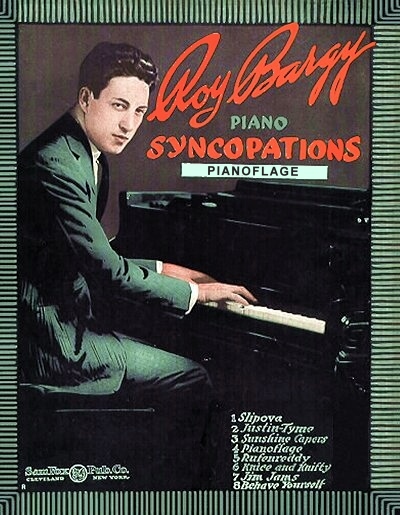 Fred Bargy was listed as a musician in the 1900 enumeration, so likely had some direct influence on his son's talent and musical direction. Roy continued taking lessons for 12 years and developed as a very competent classical pianist. He had aspirations of becoming a concert artist, but the thinking of the time was that serious pianists needed to study in Europe in order to be seriously regarded within classical music circles, a practice that continued into the 1940s. Family economics made this dream impossible to achieve at that time, as by 1910 his father was no longer working as a musician, but instead was listed as a market superintendent.
Fred Bargy was listed as a musician in the 1900 enumeration, so likely had some direct influence on his son's talent and musical direction. Roy continued taking lessons for 12 years and developed as a very competent classical pianist. He had aspirations of becoming a concert artist, but the thinking of the time was that serious pianists needed to study in Europe in order to be seriously regarded within classical music circles, a practice that continued into the 1940s. Family economics made this dream impossible to achieve at that time, as by 1910 his father was no longer working as a musician, but instead was listed as a market superintendent.
 Fred Bargy was listed as a musician in the 1900 enumeration, so likely had some direct influence on his son's talent and musical direction. Roy continued taking lessons for 12 years and developed as a very competent classical pianist. He had aspirations of becoming a concert artist, but the thinking of the time was that serious pianists needed to study in Europe in order to be seriously regarded within classical music circles, a practice that continued into the 1940s. Family economics made this dream impossible to achieve at that time, as by 1910 his father was no longer working as a musician, but instead was listed as a market superintendent.
Fred Bargy was listed as a musician in the 1900 enumeration, so likely had some direct influence on his son's talent and musical direction. Roy continued taking lessons for 12 years and developed as a very competent classical pianist. He had aspirations of becoming a concert artist, but the thinking of the time was that serious pianists needed to study in Europe in order to be seriously regarded within classical music circles, a practice that continued into the 1940s. Family economics made this dream impossible to achieve at that time, as by 1910 his father was no longer working as a musician, but instead was listed as a market superintendent.Discouraged but not daunted, Roy began to hang around the growing Toledo jazz community and, still in his teens, found work playing piano and organ in silent movie houses. He also organized his own pickup orchestra, which played for school dances. Roy took lessons in both organ and piano with C. Max Ecker of Toledo for as long as seven years. He often cited Ecker as the person responsible for the development of his dazzling technique. He claimed to have attended no music conservatory, and beyond his time with Ecker to have never studied composition, harmony, theory, or similar courses that most arrangers and composers were taking at that time. His knowledge in these fields was mostly self-taught, and came from his observation of how the instruments in an orchestra complimented or interplayed with each other.
Roy's 1917 draft card shows him listed as a musician playing for a Toledo country club. He ended up being enlisted for five months of 1918, serving in the Army in Central Officer's Training School in Georgia,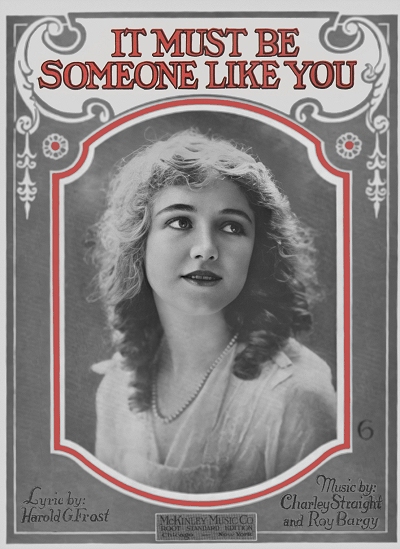 and was honorably discharged at the end of November. In a Music Trade Review article of September 13, 1919, it was noted that: "Mr. Bargy was in an officers' training camp when the Germans resigned, and while in the service was a great organizer of bands and orchestras among the soldiers. He has played in many parts of the country and wherever he has appeared his true musicianship has been appreciated."
and was honorably discharged at the end of November. In a Music Trade Review article of September 13, 1919, it was noted that: "Mr. Bargy was in an officers' training camp when the Germans resigned, and while in the service was a great organizer of bands and orchestras among the soldiers. He has played in many parts of the country and wherever he has appeared his true musicianship has been appreciated."
 and was honorably discharged at the end of November. In a Music Trade Review article of September 13, 1919, it was noted that: "Mr. Bargy was in an officers' training camp when the Germans resigned, and while in the service was a great organizer of bands and orchestras among the soldiers. He has played in many parts of the country and wherever he has appeared his true musicianship has been appreciated."
and was honorably discharged at the end of November. In a Music Trade Review article of September 13, 1919, it was noted that: "Mr. Bargy was in an officers' training camp when the Germans resigned, and while in the service was a great organizer of bands and orchestras among the soldiers. He has played in many parts of the country and wherever he has appeared his true musicianship has been appreciated."In the summer of 1919, Bargy auditioned for pianist Charley Straight, manager of the Imperial Player Rolls company. He was asked to arrange a pop tune for roll. The initial cut was so good that Bargy was quickly hired and the tune was put into their catalog. Straight cultivated Roy's arranging abilities as he was assigned to record novelties and popular songs. He soon challenged Bargy to compose some of his own novelties in an effort to compete with rising star Zez Confrey of QRS. Bargy came back with six of the Eight Piano Syncopations that were every bit as innovative as Confrey's (with whom he became a long-time friend), but his pieces were not quite as accessible to the average pianist. The six were committed to piano rolls in 1920 and published as sheet music from the rolls two years later. Two others were most likely written by Straight in 1918 or so, but Bargy got collaboration credit when they went to sheet form. All eight were recorded for Victor records between 1921 and 1924, but only six of the discs were issued commercially.
It was Straight that introduced Bargy to booking agent Edgar Benson who had just formed a dance orchestra which was slated to record for Victor Records. Benson was impressed by Bargy's skills and took him on as both pianist and musical director. The Victor recordings of The Benson Orchestra, which were very progressive for the time, helped secure many other bookings for Bargy as a pianist and arranger for other recording bands such as Isham Jones.
Roy was married to his first wife Gretchen Butler, also from Toledo, around this time. Their daughter Jeanne Phyllis was born in 1922. Their other daughter, Patricia, followed in 1924.
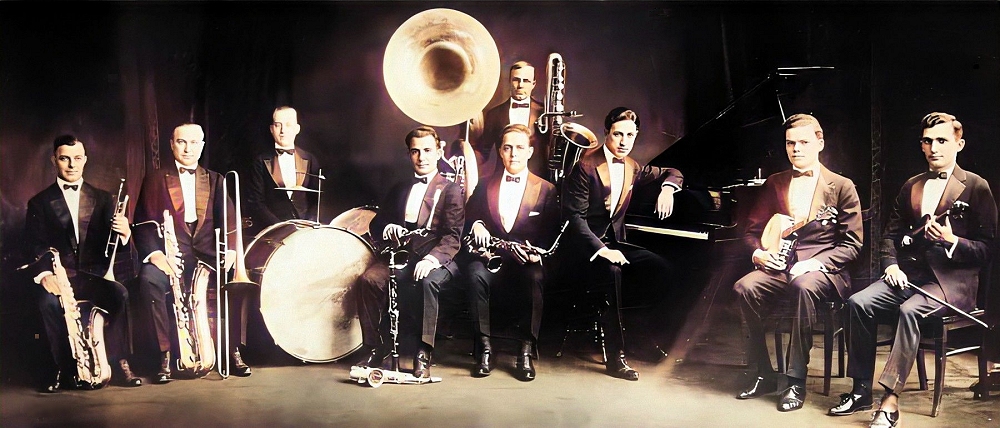 |
After creative conflicts with Benson in late 1921, Bargy left to launch his own orchestra, taking many members of Benson's group with him. He was helped by music entrepreneur Ernie Young, who managed not only to get Bargy's group booked for a solid year at the Trianon Ballroom in Chicago, but made certain that the group was the highest paid dance orchestra in the country in 1923. But the group disbanded after only a couple of years, after which Bargy joined the Isham Jones organization for a while. Roy traveled with that group to England and Europe in 1925, shown arriving back in the United States on the Mauretania on December 8, 1925. He had also done a couple of recordings with Arthur Pryor's band earlier in the year.
In 1926 Bargy continued again with his own orchestra, this time playing at the Hotel Stevens in Chicago. In May of 1927 Roy was signed by Ampico as a roll recording artist. Bargy then migrated to Paul Whiteman's orchestra on February 1, 1928, quickly becoming Whiteman's musical assistant. Whiteman had been looking for a sound beyond the conventional dance band, and Bargy's arrangements provided much of that sound, some of them commissioned even before he joined the orchestra. Bargy claimed he joined Whiteman's organization so he could go to Europe with the group, which did happen in short order. Roy's piano was the featured attraction in Whiteman's film debut of George Gershwin's Rhapsody in Blue in the Technicolor extravaganza King of Jazz, released in 1930.
Bargy was partially responsible for the symphonic arrangement of Rhapsody in Blue, which varied in many ways from the original jazz band arrangement by his colleague Ferdé Grofé. It was played at the Hollywood Bowl in the summer of 1929 while the band was staying in Los Angeles waiting for the King of Jazz producers to come up with a script, much less a format, and for filming to start. His pianistic skills were also utilized on some of the early recordings made by Whiteman's star singer, Bing Crosby and the famous Rhythm Boys. For the 1930 enumeration Roy was difficult to locate as he was on tour, although Gretchen and their two daughters were living in his home base of Toledo.
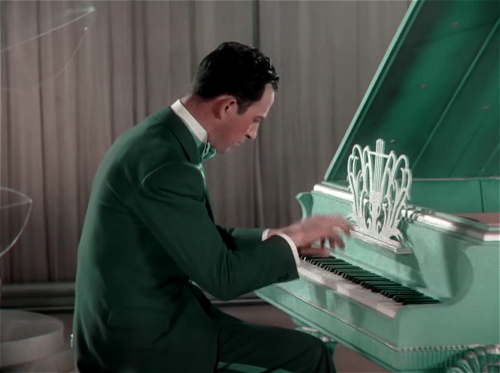 |
During the 1930s when Bargy wasn't playing with Whiteman during the occasional hiatus of the group, he would again assemble his own orchestra to work during the tour breaks. He and his groups continued to record for Victor Records, and were frequently heard on national radio broadcasts, mostly on NBC stations. As a member of the Whiteman Orchestra Roy became one of the premier interpreters of Rhapsody in Blue, and as of 1938 likely held the record for the number of performances of the work by one pianist. Soon after it was premiered, he was also featured in many performances of Gershwin's highly challenging Concerto in F. Bargy was also the assistant conductor, put in charge whenever Whiteman left the podium. By 1936 Roy and Gretchen had divorced. On June 15, 1937 he was remarried to Virginia MacLean, two decades his junior, who he had met in Zanesville, Ohio, while on tour with Whiteman.
In 1940, Bargy left Whiteman after a twelve year stint to arrange and conduct radio orchestras and bands. These included gigs with Lanny Ross (with whom he recorded some Irish tunes), Garry Moore, and famed Latin bandleader Xavier Cugat.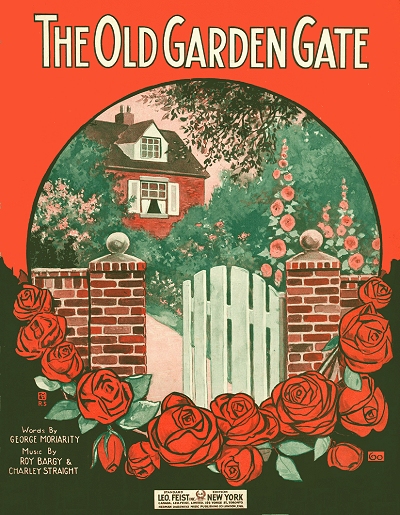 As of the 1940 census, taken in North Hempstead, Long Island, New York, Roy and Virginia had his daughter Patty was living with him, and he was listed as a musician in broadcasting. (Gretchen died in Ohio in 1946.)
As of the 1940 census, taken in North Hempstead, Long Island, New York, Roy and Virginia had his daughter Patty was living with him, and he was listed as a musician in broadcasting. (Gretchen died in Ohio in 1946.)
 As of the 1940 census, taken in North Hempstead, Long Island, New York, Roy and Virginia had his daughter Patty was living with him, and he was listed as a musician in broadcasting. (Gretchen died in Ohio in 1946.)
As of the 1940 census, taken in North Hempstead, Long Island, New York, Roy and Virginia had his daughter Patty was living with him, and he was listed as a musician in broadcasting. (Gretchen died in Ohio in 1946.)In a 1937 article published in Amarillo, Texas in September, 1937, Roy looked back on his fortunes and success. In spite of his lack of formal music education, Bargy said: "I certainly don't wish to discourage people from going to the conservatory and studying those courses which I did not have... Nevertheless, I believe the method I followed of studying privately with one excellent piano teacher for some seven or eight years, and the way I had to dig out my extra musical knowledge alone, was the best thing for me." When asked if his former instructor, Max Ecker, was proud of his achievements, he continued: "Proud of me? Oh no, he's disappointed! He thinks it's been very fine for me to be with a great orchestra like Whiteman's, but he doesn't think that is my field. He accepts the concert stage for me and nothing else." Bargy also made it clear that he liked his work on the radio more than anything else at that time. Yet, when asked, he rejoined Whiteman for some recordings for the new startup, Decca Records, from 1938 into 1940, including recapping some of his more ambivious Gershwin performances, such as Rhapsody in Blue, the Second Rhapsody, and the iconic Concerto in F.
Comedian Jimmy Durante, himself a competent pianist who got his start playing at Coney Island during the ragtime era, hired Bargy as musical director in 1943, and it was in this capacity that he remained until both of them retired from show business two decades later. Bargy and his orchestra were featured on the radio weekly on the show that originally starred both Durante and Moore on NBC radio. When Moore went to TV, Durante re-teamed with Alan Young, and retained Bargy for radio and live appearances. Roy's daughter Jeanne had debuted at age 13 on WPSD radio in Toledo in the mid-1930s as "the Voice of the Blues." She started to make a name for herself as a pianist and singer in the mid-1940s, appearing at various venues around the country, and favoring the style of her mother's good friend, singer Mildred Bailey. Jeanne also had a stint on CBS radio from 1948 to 1949.
While the circumstances are not fully clear yet, Roy and Virginia acquired two more children by adoption, who appear to be a brother and sister born in South Dakota. Roger Michael (MacLean) Bargy (03/08/1941) and Susan M. (MacLean) Bargy (c.1945), possibly the children of one of Virginia's siblings, became members of the Bargy clan in the mid-1940s.
An unfortunate accident involving a soda pop bottle exploding resulted in Roger losing his left eye in 1948, to which Roy sued the company (unnamed in the news reports) on Roger's behalf for $25,486. The 1950 census showed the family residing in Los Angeles with Roy as a music arranger for a radio studio.
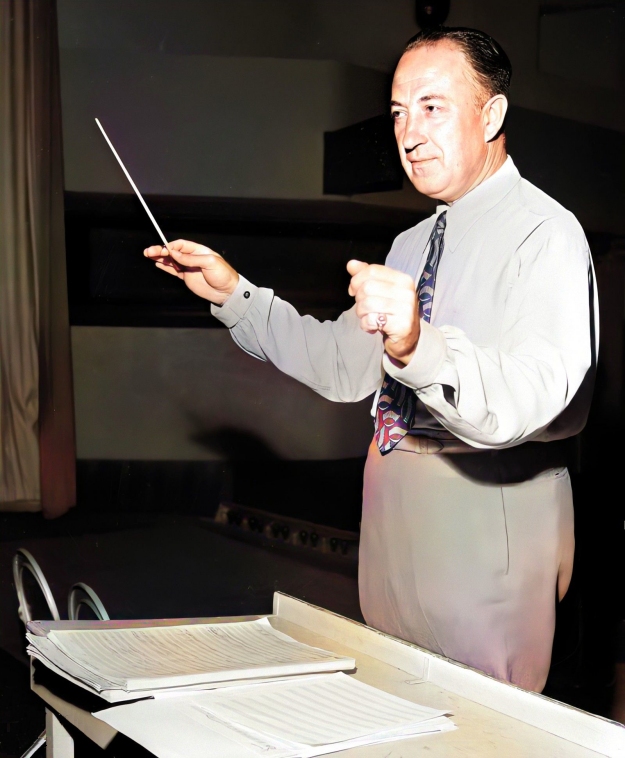 |
There were two bits of nostalgic resurgence involving Roy in the early 1950s. The first was a series of brilliant interpretations of his early piano novelties by performer Ray Turner, who was known as "The Hollywood Pianist" due to his soundtrack work that made actors sound like accomplished musicians. Turner's recordings for Capitol Records appeared both as solos on a 16" radio transcription and on two albums as well, the pioneering Honky Tonk Piano and Turner's own Kitten on the Keys. While mostly faithful to the original score, some were recorded with a piano trio, giving them a little more verve and depth than the solo performances.
There was also a brief reunion of Roy with Paul Whiteman in 1953 when the two played along with others in a traveling revue. An advertisement for them in Reno, Nevada, in July, 1953, showed the "King of Jazz" on the same bill as the "Piano Extraordinary" of Bargy along with some teen-aged musical acts from Whiteman's television show. Beyond this period, live or recorded performances unfortunately became more difficult for Roy in the mid-to-late-1950s due to the onset of arthritis, so appearances by Bargy with Whiteman or Durante diminished throughout the decade. One of their last performances together was for Durante's Fiftieth Anniversary in Show Business special, broadcast in full color on NBC Television on August 9, 1961.
Roy spent the remainder of his years in the California sunshine playing golf for enjoyment, but also helping his second wife Virginia with the Country Day School she founded in Vista, just a bit north of San Diego. Students have memories of him as both the cook for lunch time, as well as the entertainer from time to time for assemblies or casual afternoons. Their daughter, Jeanne, composed lyrics and some music for several stage productions throughout the 1960s with composer Jim Eiler, including some that were broadcast on NBC Television.
Novelty pianist extraordinaire Roy Bargy died in his home in early 1974 after a fruitful career in music and helping with the Country Day School. It is reported that Virginia, who moved in with one of their daughters (likely Patricia) after his death, likely disposed of some additional compositions or arrangements that he had kept around their house. Roger (a.k.a. Michael) died in 1981 on Roy's birthday in San Diego. Virginia Bargy survived Roy until April, 2005, and Susan is still around as of this writing, as is Patricia. Although Bargy left behind only a few compositions, his contributions to recorded jazz are considerable but hard to measure because he left his imprint in so many places.
Thanks to ragtime researcher Robert Bradford, a friend of Susan Bargy, who was able to provide a few pieces of information on Bargy and his later years. The remaining information was culled by the author from public records, periodicals and collective writings on novelty piano, including piano roll catalogs.